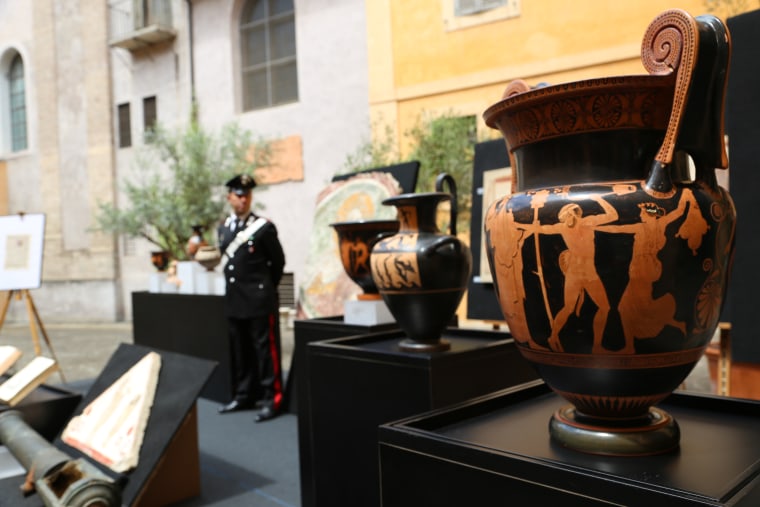ROME — Stolen works of art worth millions of dollars — including an antique Venetian canon and a 4th-century sarcophagus lid in the form of a sleeping woman — have been seized by American investigators and returned to Italy, it was announced Tuesday.
“It is my pleasure to be here today to celebrating the return of these priceless objects to their rightful owners — the Italian people,” John Phillips, the U.S. Ambassador to Italy, said during a news conference in Rome. “Italy is blessed with a rich cultural legacy and therefore cursed to suffer the pillaging of important cultural artifacts.”
Officials did not say how much the objects were worth.
The artworks were recovered by Homeland Security Investigations (HSI) from American private collectors and museums, and exhibited in Rome during a repatriation ceremony.
An Etruscan piece of pottery from the year 500 B.C., was found at the Toledo Museum of Art in Ohio, while a priceless vase from the same era was purchased by the Minneapolis Institute of Arts in 1983. Both were sold to the museums by Giacomo Medici, a well known Italian stolen art dealer, and handed to the authorities by the museums when their illicit origins were discovered.

Another collection on of precious pottery, dated to the 4th century B.C., stolen in Italy in the 1970s, were intercepted just before they were put on auction at Christie’s auction house in New York City in 2011. Three frescoes from the 1st century B.C., stolen in 1957 from the ancient site of Pompeii, were found in a private collection just before they were due to be put up for auction. Italian authorities did not say who the owner was, but described them as an “American tycoon."
Another piece, an intact Roman-era marble sarcophagus lid sculpted in the shape of a sleeping woman, was for sale in an art gallery in New York for more than $4 million before it was found and seized.
While officials from both countries said they were pleased the works had been returned, they called for tighter international controls to prevent further cross-border smuggling.
"All these items in those museums came from somewhere, but we don’t know their background,” Phillips told NBC News. “Sometimes it’s a case of 'Don’t ask, don’t tell, I don’t want to know.' That shouldn’t be a defense. You should have the affirmative obligation to document the source of an artifact, so maybe we need some new regulations and new laws in that regard.”
Interpol, the International Criminal Police Organization, estimates that the stolen art and cultural property market produces more than $9 billion in profits each year, and it’s the fourth most profitable black market trade after human trafficking, narcotics and weapons.